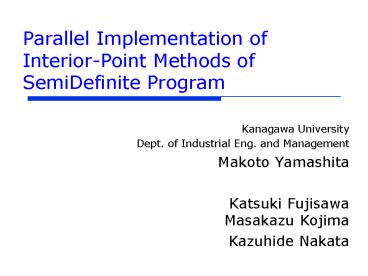Parallel Implementation of InteriorPoint Methods of SemiDefinite Program - PowerPoint PPT Presentation
1 / 26
Title:
Parallel Implementation of InteriorPoint Methods of SemiDefinite Program
Description:
SDP (SemiDefinite Program) has many applications. SDPs become ... Lagrangian Methods (PENNON) Spectral Bundle Methods (SBMethod) Low accuracy (large scale) ... – PowerPoint PPT presentation
Number of Views:31
Avg rating:3.0/5.0
Title: Parallel Implementation of InteriorPoint Methods of SemiDefinite Program
1
Parallel Implementation of Interior-Point
Methods of SemiDefinite Program
- Kanagawa University
- Dept. of Industrial Eng. and Management
- Makoto Yamashita
- Katsuki FujisawaMasakazu Kojima
- Kazuhide Nakata
2
Motivation
- SDP (SemiDefinite Program) has many applications
- SDPs become extremely large
- We want to solve large SDPs fast
- Parallel Computation is utilized
- Two parallel software were developed
- SDPARA (SDPA parallel version)
- SDPARA-C (SDPARA with the completion method)
3
Contents of this talk
- Definition of SDP and Applications
- Interior-Point Methods and Bottlenecks
- SDPARA and Concepts of Parallel-ism
- Principal Features of SDPARA-C
- Conclusion
4
Standard form of SDP
? SDPARA
? SDPARA-C
5
SDPs arise from
- Control Theory
- Combinatorial Optimization
- Quantum Chemistry
- Successive Relaxation Methods for Non-convex
optimization problem - and more direct/indirect applications
6
Quantum Chemistry
Nakata et al (2002), Zhao et al (2004)
- We want to compute the ground state energy of an
molecular - Prepare basic wave functions
- Find a wave function which minimizes the ground
state energy
Hamiltonian
7
SDP from Quantum Chemistry
- The ground state energy is an optimal value of
the SDP
Total electron numbers
Each basic wave function contains an
electronwith probability between 0,1
where
8
Existing Methods for SDPs
- Nonlinear Programming Methods
- Lagrangian Methods (PENNON)
- Spectral Bundle Methods (SBMethod)
- Low accuracy (large scale)
- Interior-Point Methods
- Primal-Dual (SDPA,SDPT3,SeDuMi)
- Dual-Scaling (DSDP)
- High stability (medium scale)
9
Primal-Dual Interior-Point Methods
10
Computation for Search Direction
2.CHOLESKY
Schur complement matrix ? Cholesky Factorizaiton
Schur complement equation
1.ELEMENTS
11
Bottlenecks on Single Processor
Parallelize in SDPARA
Computation time in second
12
Parallel implementation
- SDPARA (SDPA paRAllel version)
- Yamashita-Fujisawa-Kojima, 2002
- http//sdpa.is.titech.ac.jp/
- With libraries
- MPI-CH (An implementation of MPI)
- ScaLAPACK (Scalable Linear Algebra PACKage)
- Parallel computation for
- Elements of Schur complement matrix
- Cholesky Factorization
- on distributed memory
- Cannot store Schur complement matrix (m x m) on
memory space of single processor
13
Parallel evaluation for the Schur complement
matrix
- .
- Each element can be computed independently if
each processor stores - All elements in i-th row shares
- Row-wise distribution is reasonable.
14
Row-wise distribution for evaluation of the Schur
complement matrix
Symmetric matrix 4 Processors No
Communication Simple memory distribution
15
Redistribution of Schur complement matrix for
parallel Cholesky factorization
16
PC-Cluster
- Presto III _at_ Tokyo-Tech
- Athlon 1900 MHz
- Myrinet (High-Speed Network)
- MPICH-GM
- 760 GFLOPS
17
Numerical results ontheta 6 Lovászs theta
function(m 4375, n300)
15
5
18
Numerical results oncontrol11 by
scalability(m1596, n165)
19
SDP from Quantum Chemistry
- SDPARA can solve an extremely large SDP (m ?
24,000) in 600 second. - Without distributed memory, we cannot solve the
SDP. - For larger problems, the scalability becomes
better.
20
Weak point of SDPARA
- SDPARA can solve SDP with large number of
equality constraints - SDPARA is not suited forlarge variable matrices
. - Primal variable matrix is dense.
- The completion methodinto SDPARA ? SDPARA-C
21
Completion Method
- Instead of dense matrices
- Store such that
- The sparse structure of is determined by
Chordal Graph - Modify the Schur complement
22
Break-down of Row-wise Distribution
- Computation cost concentrates on multiplication
of inverse matrices - Strong dependency on the number of non-zero
vectors - In Max Clique Problem
- has non-zero vectors
- Each have only one nonzero
vectors - works of processor assigned to 1st row is heavy
23
Simple row-wise and Hashed row-wise
Communication
24
Main features of SDPARA-C
- The completion method
- Sparsity in primal matrix
- Hashed distribution of ELEMENTS
- Parallel computation for
- Reduction of memory space
- Solve extremely large and sparse SDPsm large, n
large (m, n ? 40,000)
25
Conclusion
- How to solve extremely large SDPs fast
- Parallel for ELEMENTS and CHOLESKY
- SDPARA solves SDPs with many equality constraints
very fast - Satisfying scalability and load-balance
26
Future Directions
- Combination of SDPARA, SDPARA-C
- SDPARA Dense or Medium
- SDPARA-C Sparse or Large
- Distribution of variable matrices































